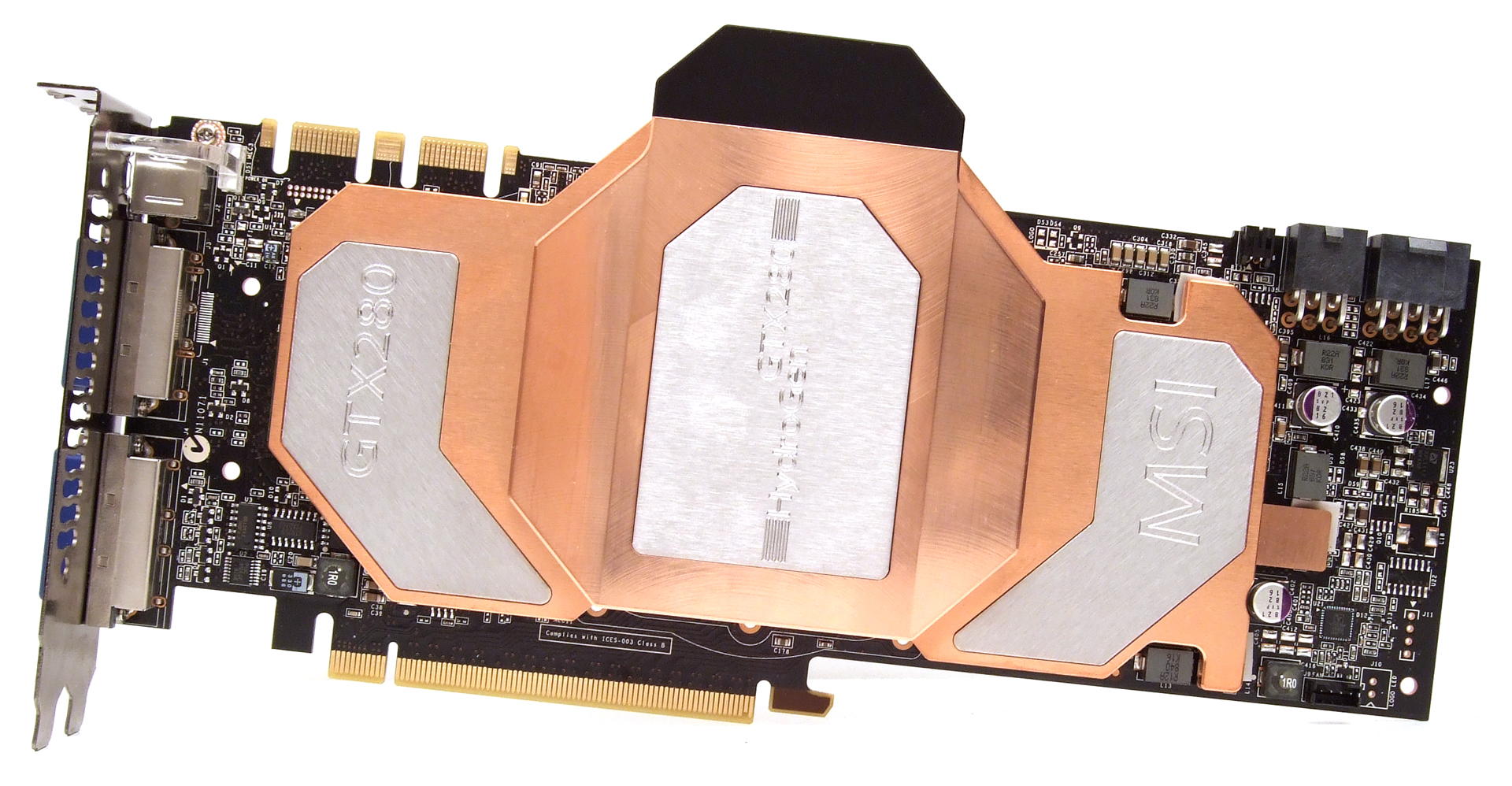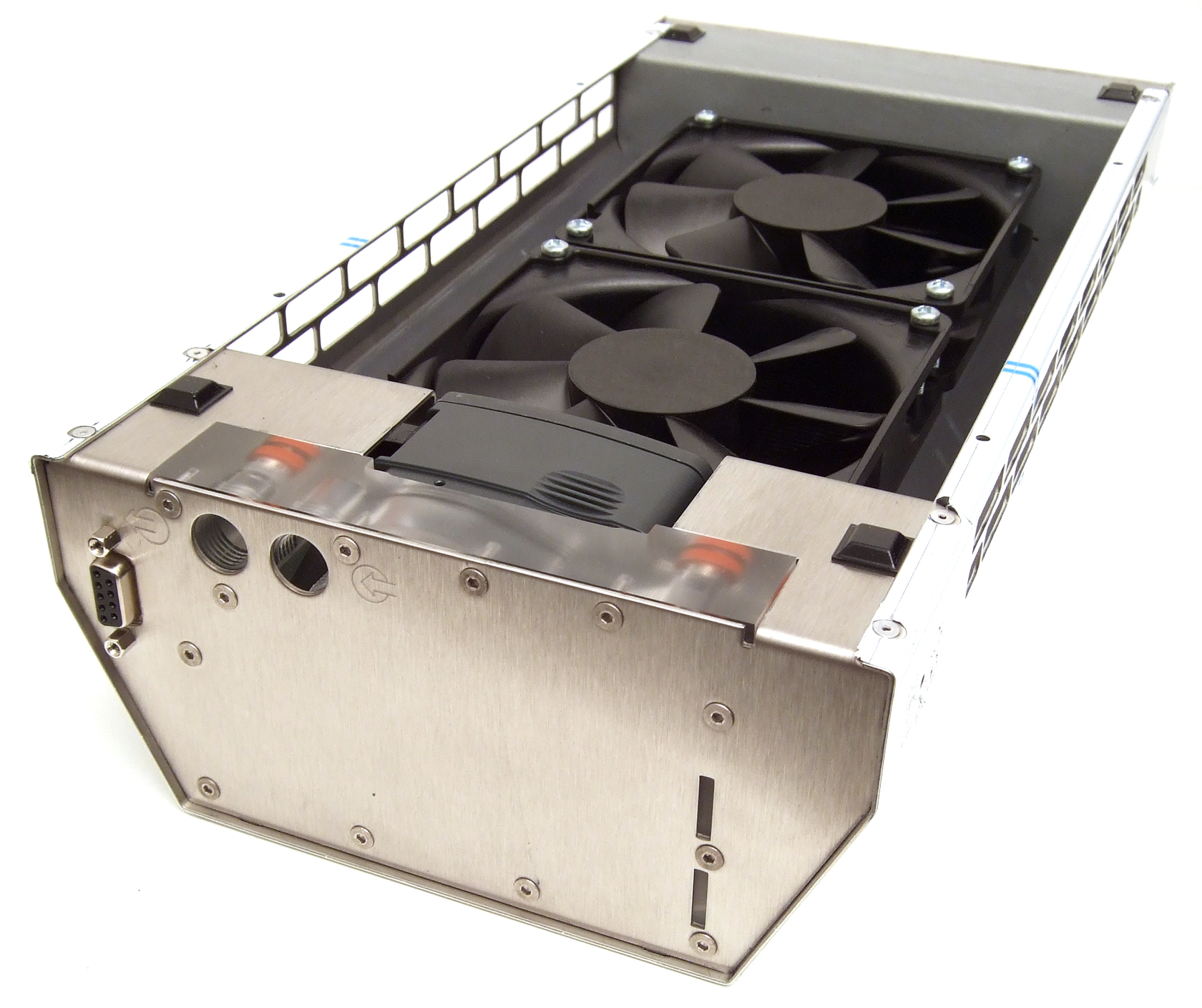High-End Graphics Card Roundup
MSI N280GTX OC HydroGen (1,024 MB)
To see all pictures, please click on the photo of the test card below to access our photo gallery.
Our second water-cooled graphics card comes from MSI (which also provided us with its HydroGen liquid-cooling system as well). As with the EVGA card, the liquid-cooling hardware itself is not included with the graphics card. But this GeForce GTX 280 model does come equipped with a big, handsome, and expensive solid-copper cooler.
Liquid cooling allows MSI to push performance further than reference models employing air do. Standard clock rates for the GeForce GTX 280 are as follows: the GPU operates at 602 MHz, the shaders run at 1,296 MHz, and the graphics memory is clocked at 2 x 1,150 MHz. Here's what you get from the HydroGen variant: 700 MHz (GPU), 1,400 MHz (shaders), and 2 x 1,242 MHz (graphics RAM). These frequencies enable this GTX 280 to keep up with overclocked GeForce GTX 285 models in our benchmark suite, while still running cool and quiet.
As with the EVGA GTX 295, the only noise you'll hear while using this board comes from the two 120 mm fans on the radiator and the water pump. MSI's HydorGen water cooling kit helps us keep thermals well under what we'd see from air cooling. At idle, for example, this card runs at 34 degrees Celsius. And during a heavy 3D graphic load, GPU core temps climb to 51 degrees Celsius. The fluid system circulates 500 cc of liquid, and at seven volts, the fans spin fairly slowly. For this test, only the graphics card was attached to the cooling system (temperatures would be higher with a CPU and other devices also in the circulation path).
The card supports DirectX 10, PhysX, and CUDA, and its circuit board is 10.5" (26.5 cm) long. In 2D mode, the card clocks down to 300/100 MHz (GPU/graphics RAM). It uses both a six-pin and an eight-pin PCIe power connector, both of which attach to the rear edge of the card. Thanks to its compact design, this card only monopolizes one expansion slot, even though the rear bracket is two slots wide (the same one used on MSI's air-cooled model). The retail packaging includes six- and eight-pin power adapters, an HDMI adapter, and S/PDIF, S-Video, and component video cables. The card also includes a status LED, plus two DVI ports and one video output on the back plate.
The MSI HydroGen HT Fusion Dual water cooling kit used to test these water-cooled cards includes the following items: a CPU cooler, just over eight feet (250 cm) of hose, connectors, and a circuit card with a power connector. The radiator, pump, and two 120mm fans are all contained within a single housing (at left). For extended use, MSI recommends using distilled water with additives to prevent corrosion and to inhibit algae. The 120 mm fans work directly with five, seven, or 12 volt power connectors. The pump includes a status LED, which lights up or blinks through the fluid reservoir.
The unit's specifications are as follows: 13.93" x 7.09" x 3.35" (345 x 180 x 85mm), 3.3 lbs. (1,500 g), 12 volt internal power supply via the PSU, and a 12 volt Eheim 600 pump.
Get Tom's Hardware's best news and in-depth reviews, straight to your inbox.
Current page: MSI N280GTX OC HydroGen (1,024 MB)
Prev Page EVGA GTX 295 Hydro Copper (2x896 MB) Next Page MSI N285GTX SuperPipe OC (1,024 MB)-
And those HAWX benchmarks look ridiculous. ATi should wipe floor with nvidia with that. Of course you didn't put dx10.1 support on. Bastard...Reply
-
cangelini quarzOnly one ATi card? What happened to all those OC'd 4890s?Reply
These are the same boards that were included in the recent charts update, and are largely contingent on what vendors submit for evaluation. We have a review upcoming comparing Sapphire's new 1 GHz Radeon HD 4890 versus the stock 4890. It'll be up in the next couple of weeks, though. -
ohim Am i the only one that find this article akward since looking at the tests done on Ati cards on The Last Remnant game makes me wonder what went wrong ... i mean it`s UT3 engine ... why so low performance ?Reply -
curnel_D Ugh, please tell me that The Last Remnant hasnt been added to the benchmark suite.Reply
And I'm not exactly sure why the writer decided to bench on Endwar instead of World In Conflict. Why is that exactly?
And despite Quarz2's apparent fanboism, I think HAWX would have been better benched under 10.1 for the ATI cards, and used the highest stable settings instead of dropping off to DX9. -
anamaniac The EVGA 295 is the stuff gods game with.Reply
I would love that card. I would have to replace my whole system to work it properly however.
I want $1500 now... i7 920 (why get better? They all seem to be godly overclockers) and EVGA 295.
How about a test suit of the EVGA GTX 295 in crossfire for a quad-gpu configuration? I know there's driver issues, but it would be fun to see what it could do regardless. Along with seeing how far Toms can OC the EVGA GTX 295.
Actually... Toms just needs to do a new system building recommendation roundup. I find them useful personally, and would have used it myself had my cash source had not lost his job... -
Weird test:Reply
1) Where are the overclocking results?
2) Bad choice for benchmarks: Too many old DX9 based graphic engines (FEAR 2, Fallout 3, Left4Dead with >100FPS) or Endwar which is limited to 30FPS. Where is Crysis?
3) 1900x1200 as highest resolution for high-end cards? -
EQPlayer Seems that the cumulative benchmark graphs are going to be a bit skewed if The Last Remnant results are included in there... it's fairly obvious something odd is going on looking at the numbers for that game.Reply -
armistitiu Worst article in a long time. Why compare how old games perform on NVIDIA's high end graphic cards? Don't get me wrong i like them but where's all the Atomic stuff from Saphire, Asus and XFX had some good stuff from ATI too. So what.. you just took the reference cards from ATI and tested them? :| That is just wrong.Reply -
pulasky WOW what a piece of s********** is this """"""review"""""" Noobidia pay good in this days.Reply

